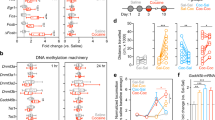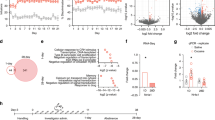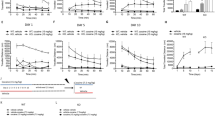Abstract
Cocaine-mediated repression of the histone methyltransferase (HMT) G9a has recently been implicated in transcriptional, morphological and behavioral responses to chronic cocaine administration. Here, using a ribosomal affinity purification approach, we found that G9a repression by cocaine occurred in both Drd1-expressing (striatonigral) and Drd2-expressing (striatopallidal) medium spiny neurons. Conditional knockout and overexpression of G9a within these distinct cell types, however, revealed divergent behavioral phenotypes in response to repeated cocaine treatment. Our studies further indicated that such developmental deletion of G9a selectively in Drd2 neurons resulted in the unsilencing of transcriptional programs normally specific to striatonigral neurons and in the acquisition of Drd1-associated projection and electrophysiological properties. This partial striatopallidal to striatonigral 'switching' phenotype in mice indicates a new role for G9a in contributing to neuronal subtype identity and suggests a critical function for cell type–specific histone methylation patterns in the regulation of behavioral responses to environmental stimuli.
This is a preview of subscription content, access via your institution
Access options
Subscribe to this journal
Receive 12 print issues and online access
$209.00 per year
only $17.42 per issue
Buy this article
- Purchase on Springer Link
- Instant access to full article PDF
Prices may be subject to local taxes which are calculated during checkout




Similar content being viewed by others
Accession codes
References
Hyman, S.E., Malenka, R.C. & Nestler, E.J. Neural mechanisms of addiction: the role of reward-related learning and memory. Annu. Rev. Neurosci. 29, 565–598 (2006).
Robison, A.J. & Nestler, E.J. Transcriptional and epigenetic mechanisms of addiction. Nat. Rev. Neurosci. 12, 623–637 (2011).
Maze, I. & Nestler, E.J. The epigenetic landscape of addiction. Ann. NY Acad. Sci. 1216, 99–113 (2011).
Rogge, G.A. & Wood, M.A. The role of histone acetylation in cocaine-induced neural plasticity and behavior. Neuropsychopharmacology 38, 94–110 (2013).
Maze, I. et al. Essential role of the histone methyltransferase G9a in cocaine-induced plasticity. Science 327, 213–216 (2010).
Covington, H.E. III et al. A role for repressive histone methylation in cocaine-induced vulnerability to stress. Neuron 71, 656–670 (2011).
Kennedy, P.J. et al. Class I HDAC inhibition blocks cocaine-induced plasticity by targeted changes in histone methylation. Nat. Neurosci. 16, 434–440 (2013).
Sun, H. et al. Morphine epigenomically regulates behavior through alterations in histone H3 lysine 9 dimethylation in the nucleus accumbens. J. Neurosci. 32, 17454–17464 (2012).
Schaefer, A. et al. Control of cognition and adaptive behavior by the GLP/G9a epigenetic suppressor complex. Neuron 64, 678–691 (2009).
Shinkai, Y. & Tachibana, M. H3K9 methyltransferase G9a and the related molecule GLP. Genes Dev. 25, 781–788 (2011).
Heiman, M. et al. A translational profiling approach for the molecular characterization of CNS cell types. Cell 135, 738–748 (2008).
Doyle, J.P. et al. Application of a translational profiling approach for the comparative analysis of CNS cell types. Cell 135, 749–762 (2008).
Lobo, M.K., Karsten, S.L., Gray, M., Geschwind, D.H. & Yang, X.W. FACS-array profiling of striatal projection neuron subtypes in juvenile and adult mouse brains. Nat. Neurosci. 9, 443–452 (2006).
Lobo, M.K., Yeh, C. & Yang, X.W. Pivotal role of early B-cell factor 1 in development of striatonigral medium spiny neurons in the matrix compartment. J. Neurosci. Res. 86, 2134–2146 (2008).
Podda, M.V., Riccardi, E., D'Ascenzo, M., Azzena, G.B. & Grassi, C. Dopamine D1-like receptor activation depolarizes medium spiny neurons of the mouse nucleus accumbens by inhibiting inwardly rectifying K+ currents through a cAMP-dependent protein kinase A-independent mechanism. Neuroscience 167, 678–690 (2010).
Lobo, M.K. et al. Cell type-specific loss of BDNF signaling mimics optogenetic control of cocaine reward. Science 330, 385–390 (2010).
Kim, J., Park, B.H., Lee, J.H., Park, S.K. & Kim, J.H. Cell type-specific alterations in the nucleus accumbens by repeated exposures to cocaine. Biol. Psychiatry 69, 1026–1034 (2011).
Hope, B.T. et al. Induction of a long-lasting AP-1 complex composed of altered Fos-like proteins in brain by chronic cocaine and other chronic treatments. Neuron 13, 1235–1244 (1994).
Lee, K.W. et al. Cocaine-induced dendritic spine formation in D1 and D2 dopamine receptor-containing medium spiny neurons in nucleus accumbens. Proc. Natl. Acad. Sci. USA 103, 3399–3404 (2006).
Nestler, E.J. Review. Transcriptional mechanisms of addiction: role of DeltaFosB. Phil. Trans. R. Soc. Lond. B 363, 3245–3255 (2008).
Robison, A.J. et al. Behavioral and structural responses to chronic cocaine require a feedforward loop involving DeltaFosB and calcium/calmodulin-dependent protein kinase II in the nucleus accumbens shell. J. Neurosci. 33, 4295–4307 (2013).
Ding, N. et al. Mediator links epigenetic silencing of neuronal gene expression with X-linked mental retardation. Mol. Cell 31, 347–359 (2008).
Gertler, T.S., Chan, C.S. & Surmeier, D.J. Dichotomous anatomical properties of adult striatal medium spiny neurons. J. Neurosci. 28, 10814–10824 (2008).
Robinson, T.E. & Kolb, B. Persistent structural modifications in nucleus accumbens and prefrontal cortex neurons produced by previous experience with amphetamine. J. Neurosci. 17, 8491–8497 (1997).
Russo, S.J. et al. Nuclear factor kappa B signaling regulates neuronal morphology and cocaine reward. J. Neurosci. 29, 3529–3537 (2009).
LaPlant, Q. et al. Dnmt3a regulates emotional behavior and spine plasticity in the nucleus accumbens. Nat. Neurosci. 13, 1137–1143 (2010).
Dumitriu, D. et al. Subregional, dendritic compartment, and spine subtype specificity in cocaine regulation of dendritic spines in the nucleus accumbens. J. Neurosci. 32, 6957–6966 (2012).
Lobo, M.K. et al. DeltaFosB induction in striatal medium spiny neuron subtypes in response to chronic pharmacological, emotional, and optogenetic stimuli. J. Neurosci. 33, 18381–18395 (2013).
Volkow, N.D. et al. Decreased dopamine D2 receptor availability is associated with reduced frontal metabolism in cocaine abusers. Synapse 14, 169–177 (1993).
Thanos, P.K., Michaelides, M., Umegaki, H. & Volkow, N.D. D2R DNA transfer into the nucleus accumbens attenuates cocaine self-administration in rats. Synapse 62, 481–486 (2008).
Gong, S. et al. Targeting Cre recombinase to specific neuron populations with bacterial artificial chromosome constructs. J. Neurosci. 27, 9817–9823 (2007).
Sampath, S.C. et al. Methylation of a histone mimic within the histone methyltransferase G9a regulates protein complex assembly. Mol. Cell 27, 596–608 (2007).
Quirion, R. et al. Human brain receptor autoradiography using whole hemisphere sections: a general method that minimizes tissue artefacts. Synapse 1, 446–454 (1987).
Tsankova, N.M. et al. Sustained hippocampal chromatin regulation in a mouse model of depression and antidepressant action. Nat. Neurosci. 9, 519–525 (2006).
Bateup, H.S. et al. Distinct subclasses of medium spiny neurons differentially regulate striatal motor behaviors. Proc. Natl. Acad. Sci. USA 107, 14845–14850 (2010).
Acknowledgements
This work was supported by grants from the US National Institute on Drug Abuse and National Institute of Mental Health, among others: P01DA08227 and P50MH96890 (E.J.N.), MH092306 (D.C., M.-H.H.) and J&J/IMHRO (M.-H.H.) and DA025962 (A.S.). The following provided additional support for this work: NARSAD Young Investigator Award (18194; A.S.) and the Seaver Foundation (A.S.).
Author information
Authors and Affiliations
Contributions
I.M. and E.J.N. conceived the project. I.M., D.C., Y.L.H., M.-H.H., A.S. and E.J.N. designed the experiments. I.M., D.C., D.M.D., M.V.S., P.J.K., M.K.L., S.E.S., M.L.M., R.C.B., H.S., L.S. and A.S. collected and analyzed the data. G.T. and R.L.N. provided human tissue and essential viral vector reagents, respectively. I.M., A.S. and E.J.N. wrote the manuscript.
Corresponding authors
Ethics declarations
Competing interests
The authors declare no competing financial interests.
Integrated supplementary information
Supplementary Figure 1 G9a expression is reduced in NAc of human cocaine addicts
G9a protein expression is significantly reduced in NAc of cocaine-addicted individuals. Western blot results for all 18 individuals are shown. G9a protein expression was normalized to GAPDH levels.
Supplementary Figure 2 Regulation of other HMTs by G9a KO in Drd1 and Drd2 MSNs.
G9a KO in Drd1 and Drd2 MSNs results in non-significant trends for reduced expression levels of Glp in both cell types. In contrast, there was no change in Suv39h1 expression in either cell type.
Supplementary information
Supplementary Text and Figures
Supplementary Figures 1 and 2 and Supplementary Table 1 (PDF 623 kb)
Supplementary Table 2
List of genes significantly regulated by cocaine, G9a KO, or both in striatal Drd1 neurons (XLS 270 kb)
Supplementary Table 3
List of genes significantly regulated by cocaine, G9a KO, or both in striatal Drd2 neurons (XLS 566 kb)
Supplementary Table 4
List of genes significantly enriched basally in Drd1 neurons in striatum (XLS 648 kb)
Supplementary Table 5
List of genes significantly enriched basally in Drd2 neurons in striatum (XLS 1008 kb)
Supplementary Table 6
List of Drd2 enriched genes displaying significant downregulation in Drd2 neurons in response to cocaine (XLS 33 kb)
Supplementary Table 7
List of Drd2 enriched genes displaying significant downregulation in Drd2 neurons in response to G9a KO (XLS 30 kb)
Supplementary Table 8
List of Drd2 enriched genes displaying significant downregulation in Drd2 neurons in response to cocaine plus G9a KO (XLS 40 kb)
Supplementary Table 9
List of Drd1 enriched genes displaying significant upregulation in Drd2 neurons in response to cocaine (XLS 33 kb)
Supplementary Table 10
List of Drd1 enriched genes displaying significant upregulation in Drd2 neurons in response to G9a KO (XLS 43 kb)
Supplementary Table 11
List of Drd1 enriched genes displaying significant upregulation in Drd2 neurons in response to cocaine plus G9a KO (XLS 47 kb)
Supplementary Table 12
mRNA primers (DOC 30 kb)
Rights and permissions
About this article
Cite this article
Maze, I., Chaudhury, D., Dietz, D. et al. G9a influences neuronal subtype specification in striatum. Nat Neurosci 17, 533–539 (2014). https://doi.org/10.1038/nn.3670
Received:
Accepted:
Published:
Issue Date:
DOI: https://doi.org/10.1038/nn.3670
This article is cited by
-
Histone Methyltransferase G9a Plays an Essential Role on Nicotine Preference in Zebrafish
Molecular Neurobiology (2024)
-
A single-cell trajectory atlas of striatal development
Scientific Reports (2023)
-
Establishment of H3K9-methylated heterochromatin and its functions in tissue differentiation and maintenance
Nature Reviews Molecular Cell Biology (2022)
-
Safrole oxide induced 5-HT neuron-like cell differentiation of bone marrow mesenchymal stem cells by elevating G9a
In Vitro Cellular & Developmental Biology - Animal (2022)
-
FOXP1 negatively regulates intrinsic excitability in D2 striatal projection neurons by promoting inwardly rectifying and leak potassium currents
Molecular Psychiatry (2021)



